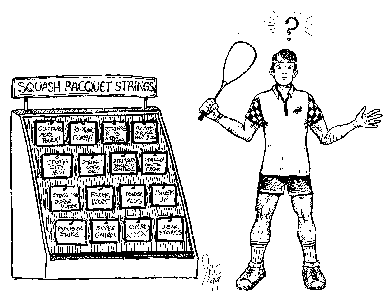|
|

Change Your String to Tweak Your Game
By Steve Crandall
Vice President, Sales & Marketing
Ashaway Racket Strings
 Racquet string has a major influence on your squash game. Almost anything you don't like about your racquet can be improved by careful string selection and proper stringing. Too little power? Too much vibration? Not enough "bite" on the ball? Give your racquet to a professional stringer, have him or her install the right string at the proper tension, and presto! It's like getting a new racquet for about $25! Racquet string has a major influence on your squash game. Almost anything you don't like about your racquet can be improved by careful string selection and proper stringing. Too little power? Too much vibration? Not enough "bite" on the ball? Give your racquet to a professional stringer, have him or her install the right string at the proper tension, and presto! It's like getting a new racquet for about $25!
That said, finding the right string and the proper tension takes a bit of work, because there are a lot of variables to consider. There are dozens of squash strings on the market, differing in terms of gauge (or thickness), materials of construction, and how those materials are put together. Aside from gauge, you can't see these differences, but be assured, they're real. If you're skeptical, try playing two identical racquets, one strung with a monofilament nylon, and the other with a multifilament Zyex(r) string. If you can't feel a difference, then squash just isn't your game. Stay home and watch professional wrestling instead.
The differences between the strings themselves aren't the only variables to consider when choosing string and tension. The racquet itself makes a difference, as does the frequency with which you're willing to restring it. Your abilities, your style of play, and your personal preference for how the racquet should feel should also influence your choices.
How do you sort through all the variables and find the best string for your game? You could try every string that's available, but that would take a long time and cost a lot of money. You could go for a Masters degree in textile engineering, but that would take a really long time, and you still wouldn't know which string feels best.
The best route is to learn just enough to focus your attention on a few strings that seem to have the right characteristics for your game, then test those strings. Each time you restring, try a change in tension or a change in model. Keep tweaking until you find the combination that feels right, and stay with it for a while. As your abilities improve or your tastes change, don't be afraid to change your string setup to keep pace. If you learn about a new model that seems right for you, go ahead and try it. You can always change back if it's not.
The most basic decision-the only one we have remaining space for-is string gauge. You have two choices: thin or thick. Thin, in squash, means 18 gauge, which is anywhere from 1.06mm to 1.15mm in diameter. Thick means 17 gauge, which ranges from 1.16mm to 1.25mm. All other things being equal, thinner strings provide more power, while thicker strings provide more control and durability.
The durability issue is obvious, but the other two bear some explanation. Thinner string is bouncier. Hit the ball, and the string stretches back, then suddenly springs forward. This "trampoline effect" is where power comes from. Thinner string, more stretch, more power.
Thicker string is stiffer, so when you hit the ball, the "stringbed," or racquet face, remains flatter. It's easier to control the direction of the ball when it's bouncing off a flat surface, and that goes double when you're "cutting" the ball.
We'll look at other topics in future issues, including tension, materials, construction, breakage, and more. But for now, you already know enough to narrow the field in half. Need more power? Go for an 18-gauge string. More control? Think 17.
This article previously appeared in Squash Magazine.
ZYEX® is a registered trademark of Victrex Ltd.
|